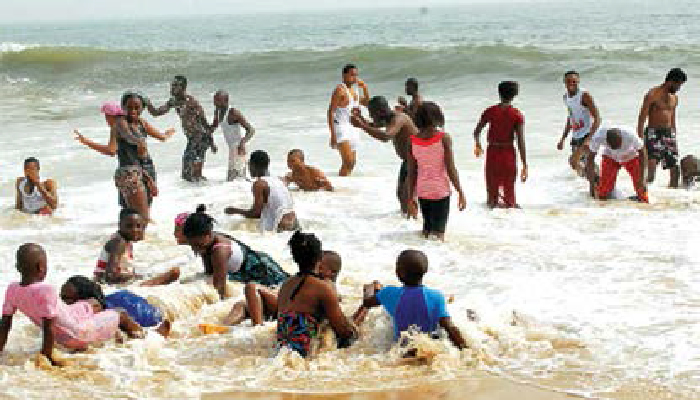
Beaches continue to offer grand relaxation for people seeking to party, isolate for meditation or simply to enjoy the coolness of water through swimming. Beaches are among the vacation spots for tourists all over the world.
There are areas with coastlines in Nigeria, resulting in the establishment of beaches in states in the country. Lagos has the highest number of beaches. Some of the beaches in Nigeria include Ibeno beach in Akwa Ibom, Calabar Beach, Suntan Beach in Badagry, Lagos, Oniru Beach in Lagos, Patigi Beach in Kwara State among many others.
Despite the fun available at beaches, beach drowning is a feature. Deaths are often recorded at private and public beaches across the world. As it is fast and silent, happening within the short period of 20 to 60 seconds, there is no discrimination to who could get drowned or not. Every individual is vulnerable and at the high risk of being drowned since it mostly happens out of expectations.
The World Health Organisation however stated in its report that there are more than 234, 000 estimated annual deaths resulting from drowning globally. The figure indicated the death of an average of 647 people per day. This contributes to the leading cause of unintentional injury death worldwide as it further revealed that drowning in Africa has the highest number of 13.1 per 100,000 populations, WHO said.
WHO added that in 2019 only about 236,000 people lost their lives after drowning making it a major problem globally as drowning is seen as the third leading cause of unintentional injury death, accounting for seven per cent of all injury-related deaths. The burden becomes global in all economies and regions especially in low and middle income countries accounting for over 90percent of unintentional drowning deaths.
In Nigeria however, the recent case was that of two unidentified men who reportedly died in December 2022 after drowning at about 150 metres away from the fence line of Barracuda Beach in Lagos State. Many incidences of such had happened in the past with families losing their loved ones.
In August 2022, 10 teenagers who visited the Elegushi Beach in Lekki, Lagos State, for the celebration of their success in the West African Senior School Certificate Examination got drowned after going to an unmanned section of the beach to swim against the beach authority’s warnings. Six out of them were rescued alive but the remaining four lost their lives. Similarly in the same month, another case of a 26-year-old man happened after swimming with his friends at Alpha Beach in Lagos State.
It was reported that two male teenagers also drowned in April 2020 during a swimming activity at a community beach in the Ibeju-Lekki area of Lagos State.
Findings showed that between May and September 2019, a total of 24 deaths resulting from drowning were recorded across some states of the federation. Some of the states include Kano, Kebbi, Benue, Delta, Akwa Ibom, and Cross River. From the figure, Benue and Akwa Ibom states had 10 deaths each. Between 2018 and 2019, the death of three teenagers including two boys and a girl who drowned in a beach at Mkpanak community made it a total of ten persons to have died in Ibeno beach in Ibeno Local Government Area of the state.
In Taraba State, nine out of the 22 members of the National Youth Service Corps who were on a picnic to the River Mayo-Selbe in the Gashaka LGA in August 2018, drowned while swimming after a sudden upsurge in the volume of water swept them away. Similarly, Sokoto State recorded 42 cases of drowning in January, March, June, and August same year.
Speaking on the issue, a Technical Advisor at Safety Consultants and Solutions Provider, William Nwaogu, explained that beach goers need to consider the weather forecast for the beach they are visiting because they are attempting to make use of the beach. He further blamed poor construction, monitoring and control of the facilities as the reason such incidents happen across the country.
He said, “When that happens, it results in overflowing of rivers and other water bodies and the tides will also increase the limit. Other causes include poor construction, monitoring and control. People build houses to block water channels and the water cannot find their way to the rivers and ocean and they collect forming flood. People fall victim to this because of ignorance and not being informed about emergency response procedures.”
He noted that cases of drowning at beaches could be curtailed when necessary safety communications and equipment were provided for the users.
He added that safety materials such as life jackets, safety floater, life raft, line throwers, whistles and emergency alarms among others should be made available at various beaches before users could make use of it, noting that proper monitoring of activities and periodic inspection of the facility should be done by the necessary regulatory bodies.
He stated, “There should be emergency communication and weather forecasts because climatologists will always warn that there will be heavy rainfall and likely flooding but many people do not go with the weather, whereas when they take that into consideration they will know they really have to be careful. They should have life jackets, safety floaters, life rafts (an inflatable boat-like equipment used by rescuers), and line throwers. There should be safety notices and emergency alarm systems around the beach. As people are coming in, the administrators of the beach could hand over the safety equipment to them.
“There should be monitoring and enforcement by beach authorities and government regulatory bodies should have their agents in those areas to check for compliance to such instructions. Regular auditing can also be done to check people are complying with the rules from time to time and there should be security cameras to record what is going on around the beaches. They should cite out the necessary locations and the best ways to do that is periodic inspections and to audit the system and structures put in place in the facility.”
Commenting on the issue, a water safety expert, Larry Atiegoba, advised beach goers to be sure of their health status before going to beaches.
He urged beach authorities to examine and confirm their customers’ health status before allowing them on the beach, noting that it might be difficult for an intoxicated tourist to realise when he or she was near a danger zone.
Atiegoba further stated that while caution signs were essential equipment to be present at restricted zones on the beach, other safety materials including life jacket, zebra line, whistle, first aid kit, signal lights, among others should be made available by the beach authorities to every tourist.
He said, “There are caution signs needed in dangerous areas where people are not meant to go. The sign is to tell them that unqualified members should not go to restricted areas. People can easily be stopped by putting caution signs at restricted zones but some Nigerians will not obey the signs. It is good to have them there so that people will at least be aware of the danger areas in the zones.
“Awareness should also be created for people to know that it is not only about setting up a beach but for them to also know the importance of safety and alert the people that come in there to be careful about certain parts of the beach. They need to know all of these. They need to have instructors that will always guide beach goers on safety measures. Lifejacket with whistle, signalling light in case there is an emergency they can easily blow the whistle for people to know that there is a danger in that zone. It is good to have a first aid kit around the beach so that when someone has an injury he or she can easily be treated immediately before rushing the person to the clinic.”
Also, a water treatment expert, Stephen Olutola, said that most drowning cases in recent times were more often than not caused by peoples’ attitudes to safety measures on the beach, highlighting the importance of employing qualified and competent safety experts at various beaches across the country.
He added that there should also be regular training for the instructors to be updated on the latest and best practices of rescuing victims during emergencies.
He said, “The cause of drowning is mainly people’s attitude to safety. When they know they cannot swim, they are not supposed to go deep into the beach. The preventive measure is to have a safety officer on ground that will monitor activities going on there. There should be a tower where the instructors can easily have a broad view of the beach to monitor the users such that even when there is an emergency they can easily know. People should be driven away from the beach if they do not adhere to the instructions given to them. That is part of the duties of a safety officer. Emergency ambulances, a tube with a rope and the safety officer also need to have safety equipment too. This will prevent the safety officer from also getting drowned while trying to rescue a victim. That will also reduce panic.”
He stated that while the government ensures rules and regulations for beach operators, a periodic check on their operations and compliance level to rules would also help in curtailing the rate of drowning across the country.





